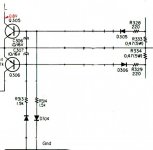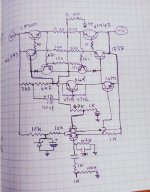It's quite effective at limiting the current as long as something else limits the current coming from the previous stage (otherwise you just blow up the current limiter transistors and/or the previous stage). Whether limiting the current is enough to ensure that the output stage transistors will survive depends on the SOAR and cooling of the output transistors.
When the amplifier is designed poorly, the current limiter could blow up itself or the VAS. Then again, maybe the base current of the output transistors at 15 A...18 A collector current is high enough to blow up the drivers (which would also be poor design).
I'll try this one from sony instead.In the attachment a limiter from Sony is shown (removed some clutter). Better have the caps bipolar!
When you short the output and when there is some DC offset, one of the output transistors will conduct 15 A...18 A while its collector-emitter voltage is almost 42 V. Best case and neglecting a small contribution due to base current, its power dissipation will then be 630 W.
According to the SOAR graph in the 2SC5200 datasheet (Fairchild datasheet revision C), it can survive 15 A at 42 V for 10 ms when its case is kept at 25 degrees Celsius. The same holds for the 2SA1943 according to its Toshiba datasheet. Something else needs to ensure the current is cut off well within 10 ms.
The hFE of the 2SC5200 is typically somewhere between 15 and 40 under these conditions, depending on junction temperature and current gain grade. For the PNP, it's between 8 and 25. At about 40 V collector-emitter voltage, the 2SA1837 and 2SC4793 can survive 660 mA for 10 ms at 25 degrees Celsius case temperature (Toshiba SOAR graph values), so an output transistor current gain below about 22 means the driver breaks down first.
The current limiter transistors and the VAS are less vulnerable, because the current that the input stage can deliver times the current gain of the VAS transistor is well below 660 mA.
According to the SOAR graph in the 2SC5200 datasheet (Fairchild datasheet revision C), it can survive 15 A at 42 V for 10 ms when its case is kept at 25 degrees Celsius. The same holds for the 2SA1943 according to its Toshiba datasheet. Something else needs to ensure the current is cut off well within 10 ms.
The hFE of the 2SC5200 is typically somewhere between 15 and 40 under these conditions, depending on junction temperature and current gain grade. For the PNP, it's between 8 and 25. At about 40 V collector-emitter voltage, the 2SA1837 and 2SC4793 can survive 660 mA for 10 ms at 25 degrees Celsius case temperature (Toshiba SOAR graph values), so an output transistor current gain below about 22 means the driver breaks down first.
The current limiter transistors and the VAS are less vulnerable, because the current that the input stage can deliver times the current gain of the VAS transistor is well below 660 mA.
Last edited:
- Home
- Amplifiers
- Solid State
- Help a NOOB in the middle of some desert in Africa

